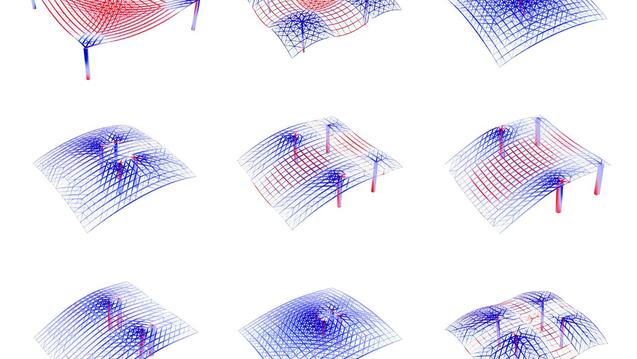
Juney Lee

Juney Lee was appointed T. David Fitz-Gibbon Assistant Professor of Architecture at Carnegie Mellon Architecture in 2023. He is deeply inspired by the creative roles that architecture and structural design can play in alleviating the impending environmental and social crises throughout the world. He is particularly interested in how more intelligently shaped and constructed structures can dramatically reduce the embodied energy of buildings, minimize construction waste and empower new materials. His transdisciplinary research aspirations across computational structural design, regenerative materials and sustainable construction methods are united by an effort to accelerate the decarbonization of the building industry through advancements of emerging construction technologies that are scalable, affordable and accessible to a wide range of environmental and socioeconomic contexts.
At CMU, Juney leads the teaching of the core structural design curriculum, as well as integrated design studios and advanced computational structural design electives. In addition to teaching, he also advises student research and thesis work across all academic levels within Carnegie Mellon Architecture and beyond. He is passionate about developing hands-on, engaging and immersive methods of teaching and learning structural design that are focused on enhancing students’ design intuition and sensibility, which are increasingly more important and necessary human skills in light of rapidly evolving generative AI-based design tools.
Juney started his architectural journey at University of California at Berkeley, where he discovered his dual interest in structural engineering. After completing his Master of Architecture thesis under the guidance of Nader Tehrani from the Massachusetts Institute of Technology (MIT) in 2014, he continued his interdisciplinary education and research at MIT's Department of Civil and Environmental Engineering and completed a Master of Engineering (Structural) degree in 2015. He completed his Master of Engineering thesis titled “Grammatical Design with Graphic Statics” under the supervision of Prof. Dr. Caitlin Mueller and Prof. Dr. John Ochsendorf. The thesis investigated the potential of combining generative computational design methods with graphic statics – a graphical method of analyzing and designing structures – to automatically and rapidly generate structurally viable solutions. His work received the Marvin E. Goody Award for outstanding graduate thesis from MIT in December 2014.
In 2015, Juney received one of the Architecture and Technology Fellowships from the Institute of Technology in Architecture at ETH Zurich and continued his research in advancing computational graphic statics under the supervision of Prof. Dr. Philippe Block at the Block Research Group (BRG), Bill Baker of Skidmore, Owings & Merrill (SOM) and Allan McRobie of the University of Cambridge. His Ph.D. dissertation titled “Computational Design Framework for 3D Graphic Statics” investigated new methods of designing and form-finding of spatial funicular structures with significantly lower stresses that enable the use of non-traditional materials with lower environmental impact such as earthen materials, recycled concrete, waste products and organic matter. As the demonstrator project for his Ph.D., Juney led the structural design, fabrication and construction of the MycoTree project, a spatially branching tree structure made of load-bearing mycelium components. His Ph.D. work received the prestigious Silver Medal in 2019, the highest academic distinction awarded at ETH Zurich.
Juney has over a decade of professional architectural experience from a number of renowned design offices throughout the U.S., including SOM (San Francisco, Chicago, New York), Grimshaw Architects (New York) and TriPyramid Structures Inc. (Westford, MA). He has collaborated with designers, architects and engineers on a wide range of projects including high-rise office towers, international airport terminals, private residential homes, state-of-the-art museums, city masterplans and digital fabrication of high-end steel architectural hardware.
His diverse professional experiences have always challenged him to interrogate the practical relevance of his academic research, and he strives to translate theoretical academic investigations into the industry by gradually increasing the scale of the “proof of concept” demonstrator projects to test the economical and logistical feasibility of new ideas and methods of building. During his tenure at the BRG as postdoctoral researcher and senior researcher, Juney contributed to the construction of numerous exhibition pavilions and prototypes, some of which were showcased at the Venice Biennale of Architecture (2016), the Seoul Biennale of Architecture and Urbanism (2017), and the Architecture Biennale by European Cultural Centre (2021). Juney has also played a key role in the onsite management and execution of several building-scale construction projects. The most notable example is the roof of the HiLo unit at the Next Evolution in Sustainable Building Technologies (NEST) building in Dübendorf, Switzerland, which is a doubly curved concrete shell roof spanning 26 feet by 56 feet, realized with a lightweight and reusable cable net and formwork system.
Juney is a tireless advocate for democratization of computational design tools, research and knowledge. He believes that one’s access to digital tools is not a privilege and that anyone who wishes to design and build better for the community should have access to the computational design resources that empower them to do so. As one of the key founding contributors and software developers of COMPAS (an open-source, Python-based computational framework for collaboration and research in architecture, structural engineering and digital fabrication), Juney has played an active role in spreading the philosophy of open-source approach to computational design, research and collaboration through workshops and lectures throughout the world. One of his notable contributions has been the development of RhinoVAULT 2 (RV2), a freely available software for form finding of funicular shell structures, which has been downloaded by more than 20,000 scholars and practitioners worldwide.
Selected Publications (nonchronological)
- Lee, J. (2018). Computational Design Framework for 3D Graphic Statics. (#25526). [Doctoral dissertation, ETH Zurich]. ETH Zurich Research Collection. (link to article)
- Lee, J., Van Mele, T., & Block, P. (2018). Disjointed force polyhedra. Computer-Aided Design, 99, 11-28. (link to article)
- Lee, J., Mueller, C., & Fivet, C. (2016). Automatic generation of diverse equilibrium structures through shape grammars and graphic statics. International Journal of Space Structures, 31(2-4), 147-164. (link to article)
- Lee, J., Van Mele, T., and Block, P. (2016). Form-finding explorations through geometric transformations and modifications of force polyhedrons. In Proceedings of the International Association for Shell and Spatial Structures (IASS) Symposium 2016. Tokyo, Japan. (link to paper)
- Lee, J., Enrique, L., Van Mele, T., & Block, P. (2021). Geometry-based teaching of structures through computational graphic statics. In Proceedings of the International Association for Shell and Spatial Structures (IASS) Symposium 2021. Surrey, UK. (link to paper)
- Avelino, R.M., Lee, J., Van Mele, T., & Block, P. (2021). An interactive implementation of algebraic graphic statics for geometry-based teaching and design of structures. In Proceedings of International fib Symposium on Conceptual Design of Structures 2021. Solothurn, Switzerland. (link to paper)
- Heisel, F., Lee, J., Schlesier, K., Rippmann, M., Saeidi, N., Javadian, A., Nugroho, A., Van Mele, T., Block, P., & Hebel, D. (2018). Design, Cultivation and Application of Load-Bearing Mycelium Components: The MycoTree at the 2017 Seoul Biennale of Architecture and Urbanism. International Journal of Sustainable Energy Development, 6(1), 296-303. (link to article)
- Bitting, S., Derme, T., Lee, J., Van Mele, T., Dillenburger, B., & Block, P. (2022). Challenges and Opportunities in Scaling up Architectural Applications of Mycelium-Based Materials with Digital Fabrication. Biomimetics, 7(2), 44. (link to article)
Selected Projects
- HiLo Research & innovation unit for NEST in Dübendorf, Switzerland (2021)
- MycoTree at the Seoul Biennale for Architecture and Urbanism (2017)
- Beyond Bending II Sustainable affordable housing for South Africa at the “Time, Space, Existence” Architecture Biennale by European Cultural Centre in Venice, Italy (2021)
- COMPAS framework (2015-)
- RhinoVAULT 2 (2019-)
Spring 2025 Teaching
This course introduces structural systems and the materials and elements that make up those systems. Students study historical and contemporary examples of bridges, long-span roofs and tall buildings from technical, social and symbolic perspectives. As they learn about structures, students develop their problem solving skills and ability to communicate ideas by practicing using equations, drawing and writing.
Fulfills minor requirements for: Architectural Technology (non-majors)
This course introduces the fundamentals of strength of materials, computational modeling of structures, and basic finite element (FE) analysis. This is a hands-on, skill-building course about learning how to translate a conceptual design intent into a computational structural model, then applying material and boundary condition constraints to analyze and understand structural behavior.
Fulfills minor requirements for: Architectural Technology (non-majors)
This course introduces the fundamentals of strength of materials, computational modeling of structures, and basic finite element (FE) analysis. This is a hands-on, skill-building course about learning how to translate a conceptual design intent into a computational structural model, then applying material and boundary condition constraints to analyze and understand structural behavior.
Fall 2024 Teaching
This course introduces advanced topics in computational structural design and analysis. Through various form-finding algorithms and design methodologies, students learn how to use structural geometry as a key design driver to shape efficient and expressive forms.

